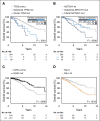Clinical impact of clonal and subclonal TP53, SF3B1, BIRC3, NOTCH1, and ATM mutations in chronic lymphocytic leukemia
- PMID: 26837699
- PMCID: PMC4912011
- DOI: 10.1182/blood-2015-07-659144
Clinical impact of clonal and subclonal TP53, SF3B1, BIRC3, NOTCH1, and ATM mutations in chronic lymphocytic leukemia
Abstract
Genomic studies have revealed the complex clonal heterogeneity of chronic lymphocytic leukemia (CLL). The acquisition and selection of genomic aberrations may be critical to understanding the progression of this disease. In this study, we have extensively characterized the mutational status of TP53, SF3B1, BIRC3, NOTCH1, and ATM in 406 untreated CLL cases by ultra-deep next-generation sequencing, which detected subclonal mutations down to 0.3% allele frequency. Clonal dynamics were examined in longitudinal samples of 48 CLL patients. We identified a high proportion of subclonal mutations, isolated or associated with clonal aberrations. TP53 mutations were present in 10.6% of patients (6.4% clonal, 4.2% subclonal), ATM mutations in 11.1% (7.8% clonal, 1.3% subclonal, 2% germ line mutations considered pathogenic), SF3B1 mutations in 12.6% (7.4% clonal, 5.2% subclonal), NOTCH1 mutations in 21.8% (14.2% clonal, 7.6% subclonal), and BIRC3 mutations in 4.2% (2% clonal, 2.2% subclonal). ATM mutations, clonal SF3B1, and both clonal and subclonal NOTCH1 mutations predicted for shorter time to first treatment irrespective of the immunoglobulin heavy-chain variable-region gene (IGHV) mutational status. Clonal and subclonal TP53 and clonal NOTCH1 mutations predicted for shorter overall survival together with the IGHV mutational status. Clonal evolution in longitudinal samples mainly occurred in cases with mutations in the initial samples and was observed not only after chemotherapy but also in untreated patients. These findings suggest that the characterization of the subclonal architecture and its dynamics in the evolution of the disease may be relevant for the management of CLL patients.
© 2016 by The American Society of Hematology.
Figures





Comment in
-
Not all subclones matter in CLL.Blood. 2016 Apr 28;127(17):2052-4. doi: 10.1182/blood-2016-02-699041. Blood. 2016. PMID: 27127300 No abstract available.
Similar articles
-
NOTCH1, SF3B1, BIRC3 and TP53 mutations in patients with chronic lymphocytic leukemia undergoing first-line treatment: correlation with biological parameters and response to treatment.Leuk Lymphoma. 2014 Dec;55(12):2785-92. doi: 10.3109/10428194.2014.898760. Leuk Lymphoma. 2014. PMID: 24597984
-
Frequencies of SF3B1, NOTCH1, MYD88, BIRC3 and IGHV mutations and TP53 disruptions in Chinese with chronic lymphocytic leukemia: disparities with Europeans.Oncotarget. 2015 Mar 10;6(7):5426-34. doi: 10.18632/oncotarget.3101. Oncotarget. 2015. PMID: 25605254 Free PMC article.
-
A reduced panel of eight genes (ATM, SF3B1, NOTCH1, BIRC3, XPO1, MYD88, TNFAIP3, and TP53) as an estimator of the tumor mutational burden in chronic lymphocytic leukemia.Int J Lab Hematol. 2021 Aug;43(4):683-692. doi: 10.1111/ijlh.13435. Epub 2020 Dec 16. Int J Lab Hematol. 2021. PMID: 33325634 Free PMC article.
-
Next-generation sequencing in chronic lymphocytic leukemia.Semin Hematol. 2013 Oct;50(4):286-95. doi: 10.1053/j.seminhematol.2013.09.005. Semin Hematol. 2013. PMID: 24246696 Review.
-
Clonal evolution in chronic lymphocytic leukemia: impact of subclonality on disease progression.Expert Rev Hematol. 2015 Feb;8(1):71-8. doi: 10.1586/17474086.2015.972930. Epub 2014 Oct 27. Expert Rev Hematol. 2015. PMID: 25345442 Review.
Cited by
-
CRISPR-Cas9 in basic and translational aspects of cancer therapy.Bioimpacts. 2024;14(6):30087. doi: 10.34172/bi.2024.30087. Epub 2024 Mar 10. Bioimpacts. 2024. PMID: 39493894 Free PMC article. Review.
-
NOTCH1 Signalling: A key pathway for the development of high-risk chronic lymphocytic leukaemia.Front Oncol. 2022 Oct 13;12:1019730. doi: 10.3389/fonc.2022.1019730. eCollection 2022. Front Oncol. 2022. PMID: 36313682 Free PMC article. Review.
-
CD49d prevails over the novel recurrent mutations as independent prognosticator of overall survival in chronic lymphocytic leukemia.Leukemia. 2016 Oct;30(10):2011-2018. doi: 10.1038/leu.2016.88. Epub 2016 Apr 25. Leukemia. 2016. PMID: 27109509
-
TP53 aberrations in chronic lymphocytic leukemia: an overview of the clinical implications of improved diagnostics.Haematologica. 2018 Dec;103(12):1956-1968. doi: 10.3324/haematol.2018.187583. Epub 2018 Nov 15. Haematologica. 2018. PMID: 30442727 Free PMC article. Review.
-
Prediction of clinical outcome in CLL based on recurrent gene mutations, CLL-IPI variables, and (para)clinical data.Blood Adv. 2022 Jun 28;6(12):3716-3728. doi: 10.1182/bloodadvances.2021006351. Blood Adv. 2022. PMID: 35468622 Free PMC article.
References
-
- Zenz T, Mertens D, Küppers R, Döhner H, Stilgenbauer S. From pathogenesis to treatment of chronic lymphocytic leukaemia. Nat Rev Cancer. 2010;10(1):37–50. - PubMed
-
- Hallek M. Chronic lymphocytic leukemia: 2013 update on diagnosis, risk stratification and treatment. Am J Hematol. 2013;88(9):803–816. - PubMed
-
- Villamor N, López-Guillermo A, López-Otín C, Campo E. Next-generation sequencing in chronic lymphocytic leukemia. Semin Hematol. 2013;50(4):286–295. - PubMed
Publication types
MeSH terms
Substances
LinkOut - more resources
Full Text Sources
Other Literature Sources
Research Materials
Miscellaneous

